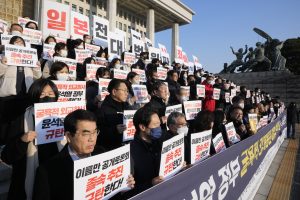South Korean officials are considering creating a domestic fund to compensate Koreans who were enslaved by Japanese companies before the end of World War II, as they desperately try to repair relations with Tokyo that have deteriorated in recent years over historical grievances.
The plan, revealed Thursday during a public hearing organized by Seoul’s Foreign Ministry, was met with fierce criticism by victims and their legal representatives, who have demanded that the reparations come from Japan.
Relations between Seoul and Tokyo have been strained since South Korea’s Supreme Court in 2018 upheld lower court verdicts and ordered Nippon Steel and Mitsubishi Heavy Industries to compensate Korean forced laborers.
The companies have refused to carry out the orders and the plaintiffs have responded by pursuing legal steps aimed at forcing the companies to sell off their local assets to provide compensation, a process South Korean officials fear would cause further rupture between Seoul and Tokyo. Victims have also demanded the Japanese companies issue an apology over their ordeals.
Ties between the U.S. Asian allies have long been complicated by grievances related to Japan’s brutal rule of the Korean Peninsula from 1910 to 1945, when hundreds of thousands of Koreans were mobilized as forced laborers for Japanese companies or sex slaves at Tokyo’s wartime brothels.
South Korean President Yoon Suk-yeol, a conservative who took office last May, has been eager to improve ties with Japan as they pursue stronger trilateral security cooperation with Washington in the face of the growing North Korean nuclear threat.
He met with Japanese Prime Minister Kishida Fumio in November in Cambodia in the first bilateral summit between the countries in three years, where they expressed commitment to swiftly resolve their “pending” issues, which clearly referred to the forced labor dispute.
During Thursday’s public hearing at the National Assembly, South Korean Foreign Ministry official Seo Min-jung said her government’s priority is to arrange the payments as quickly as possible, noting that many forced labor victims are already dead and most known survivors are in their 90s.
She said it would be “impossible” to make the Japanese companies apologize on behalf of the broader forced labor issue, which has fueled mutual frustration between the countries for decades.
“It would be important that Japan sincerely maintains and inherits the poignant expressions of apology and remorse that it already expressed in the past,” said Seo, the ministry’s director of Asia and Pacific Affairs.
Seo said the payments could possibly be handled by the Seoul-based Foundation for Victims of Forced Mobilization by Imperial Japan. Shim Kyu-sun, the foundation’s chair, said the payments could be funded by South Korean firms that benefited from Japanese economic assistance when the countries normalized their ties in the 1960s, including steel giant POSCO.
“The Japanese companies have reduced much of their economic activity in South Korea and withdrawn (many of their) assets, so it’s not even clear whether a liquidation process would be enough to provide compensation to the plaintiffs,” said Seo.
She said government officials planned to meet the victims and their family members in person to explain the payment plans and seek their consent.
Lim Jae-sung, a lawyer who represented the plaintiffs in the 2018 rulings, accused the government of pushing ahead with a settlement that excessively aligns with Japan’s position while ignoring the voices of victims.
“It seems that the South Korean government’s finalized plan is to use the money by South Korean companies like POSCO to allow the Foundation for Victims of Forced Mobilization by Imperial Japan to eliminate the forced labor victims’ rights to receivables,” Lim said. “Japan doesn’t take any burden at all.”
The 2018 rulings ordered Nippon Steel and Mitsubishi to provide around 100 to 150 million won ($80,000 to $120,000) each to 15 plaintiffs, including both survivors and relatives of deceased victims.
Lim said the amount of compensation finalized by courts could eventually exceed 15 billion won ($12 million), considering that similar cases are still pending.
“Are you planning to raise funds amounting to 15 billion won entirely from the money of South Korean companies?” Lim asked Seo, accusing the government of rushing toward a settlement that wouldn’t be supported by victims or South Korea’s broader public.
The hearing was interrupted several times by angry audience members. Some shouted “traitor” at Korea University politics professor Park Hong-kyu, who participated as a panelist, after he said it was unrealistic to expect Japan to apologize and participate in the fund.
A Foreign Ministry official, who requested anonymity during a background briefing to reporters, said the plan presented during the hearing wouldn’t necessarily be Seoul’s finalized proposal to Tokyo.
“Today’s (hearing) was not about announcing the government’s finalized plan but for us to receive the opinions of diverse groups and use this as an opportunity to accelerate discussions with Japan,” the official said.
Japan insists all wartime compensation issues were settled under a 1965 treaty normalizing relations between the two nations that was accompanied by hundreds of millions of dollars in economic aid and loans from Tokyo to Seoul.
Japan reacted furiously after the South Korean rulings in 2018 and subsequently placed export controls on chemicals vital to South Korea’s semiconductor industry in 2019, citing the deterioration of trust between the countries.
Seoul accused Tokyo of weaponizing trade and even threatened to terminate a military intelligence-sharing agreement with Tokyo, which was a major symbol of their three-way security cooperation with Washington. South Korea eventually backed off and kept the deal after being pressured by the Trump administration.
Nippon Steel and Mitsubishi Heavy Industries had refused to carry out the 2018 rulings and re-appealed to the Supreme Court after lower courts ordered them to sell off their local assets to compensate the plaintiffs.
The Supreme Court has yet to make a decision on whether to allow the liquidation of the companies’ assets to proceed.

































